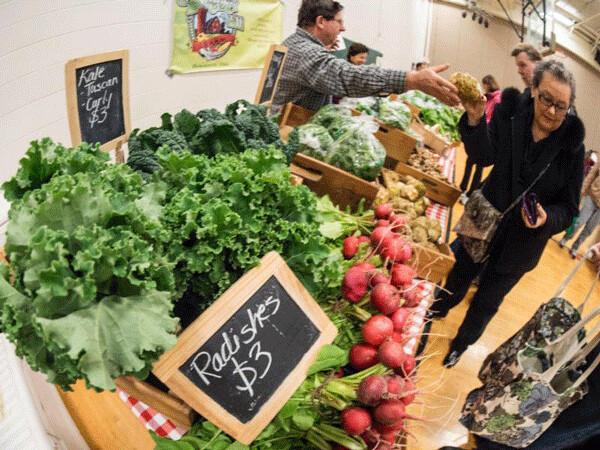News & Articles
Browse all content by date.

It wouldn’t call it a sequel, but this column follows in the footsteps of my recent Early Resolve column, which encourages readers to combat holiday decadence with green fiber. (I also have an updated version of that one, btw)
The farmers markets of summer get all the glory, but pound for pound, the winter markets have more guts. These off-season centers of homegrown commerce run from about Halloween through Easter, and are like distillations of their summer counterparts, giving farmers the chance to make a little money, while offering locals an opportunity to buy some produce. Like some secret society for extra-cheerful and healthy people, those who know about the winter market show up while the rest of the world watches cartoons.
The web page LocalHarvest.org provides online tools to help farmers thrive, and maintains a database of active farmers markets in the U.S. According to LocalHarvest’s Guillermo Payet, there are about 4,700 summer markets nationwide, compared to 1,911 winter markets. He recently added a winter market search feature to the LocalHarvest page, so shoppers can easily find the winter market closest to them.
Winter markets are smaller, cuter and cozier, with more hot cocoa on tap. Like a summer market, the winter market is like a big, living microchip of the farming community. You find out who died, who got pregnant, who grew a beard, and who went to Costa Rica. Like a fire in the dark, winter markets provide heat and light when it’s needed the most.
My winter market in Montana, which takes place in the Senior Center, which has a thrift store in the basement, is flush with “normal” cold weather crops like potatoes, squash, onions and garlic, not to mention animal and value-added products like bacon, pickles, cheese and eggs. But thanks to advances in cold-weather horticulture, and with a little help from a warming climate, there are now summery foods available, like celery, tomatoes and apples, not to mention tropical foods like lemongrass.
But the stars of the winter market are the winter greens, that large and delicious green spectrum of leaves like spinach, tatsoi, arugula, broccoli, kale, and leafy cabbages like Napa. These greens, planted during the dog days of summer, came of age in cooler, shorter days. Under these conditions, plants build themselves differently. They are smaller but sturdier, denser and crunchier. Maybe it’s the bleak context in which they appear, but wintergreens emanate a vitality that you can see and taste, like earthy, bitter candies.
Here are three recipes to help you enjoy the winter greens in season today. These dressings will also benefit many non-green crops of winter too, like radishes or cauliflower. And when the time comes, these salad sauces will help us enjoy the bounty of summer.
Crazy Mountain Blue Cheese Dressing
This recipe comes from Cheryl Marchi, proprietress of the Crazy Mountain Inn, a 117 year-old boarding house in Martinsdale, Montana where Calamity Jane once stayed. The Inn’s living room boasts a glorious wood stove that warms that room like a winter market warms a community. The adjacent café is the toast of Meagher County, and where I first tasted Marchi’s blue cheese salad dressing.
It’s thick enough to use as a dip, but not so thick that your shirt won’t look as splattered as mine does after dipping cauliflower florets too impatiently. Marchi likes it with onion-y dishes, as a dip for onion rings, or to hold the grilled onions in place on a French dip sandwich.
Yields 4 ½ cups
1/2 c milk
3 1/2 cups Best Foods mayo
6 ounces Gorgonzola
4 or 5 cloves of garlic, crushed
Lots of fresh, coarsely ground black pepper
Set a third of the Gorgonzola aside. Blend everything else together. Break apart the unblended chunk of Gorgonzola into little chunks and stir it in. Let it sit for a bit, preferably overnight.
Flower Child Lemon Tahini Dressing
This recipe comes courtesy of Flower Child vegan restaurant chain. This sauce is an emulsion, meaning it won’t separate after you mix it up. In other words, it’s basically lemon tahini mayo, which is pretty special. If you add a yolk it will emulsify even thicker, but that of course would cause the dressing to lose its veganity.
The dressing also contains nutritional yeast, aka “Hippy Dust,” which seems appropriate for a restaurant called Flower Child. The yeast confers a meaty strength to the dressing, which isn’t surprising because Hippy Dust is 100 percent yeast meat.
If your garlic is large of clove, like mine, you might not want to use the full eight cloves called for. So use your best judgement, but no fewer than three cloves. The acid, sweetness, saltiness and richness of this dressing makes it a great blanket to a pile of earthy leaves.
Yields 1 ½ cups
8 cloves of garlic-peeled
½ cup fresh lemon juice
2 ½ tablespoons tahini
1 teaspoon whole grain mustard
2 teaspoon evaporated cane sugar
1 teaspoon kosher salt
1 tablespoon nutritional yeast
¼ c extra virgin olive oil
½ c grapeseed oil
Put the first 7 ingredients in a blender and process on medium speed for 15 seconds. While machine is running, slowly pour in the oils until emulsified. Place in covered container in refrigerator until needed.
Mrs. LeVaux’s All-Purpose Dressing
My wife is convinced that every homemade salad dressing needs more salt, and I think she may have a point. Her go-to dressing is basically oil and vinegar, plus a bunch of soy sauce.
1 cup extra virgin olive oil
½ cup soy sauce
¼ cup cider vinegar
¼ cup lime or lemon juice
¼ cup balsamic
Combine ingredients, dress or dip your salad. If dipping, replenish the oil as necessary.
This dressing is especially good on bitter vegetables, like radicchio. The flavors of the dressing engage those of the greens on many levels, disarming and charming those tasty winter greens, leafing you wanting more.
| Tweet |


